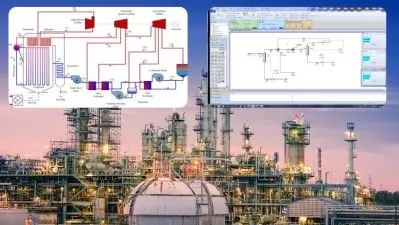General Chemistry - Electrochemistry and the Galvanic Cell
Justin Ketcham
1:41:54
Description
General Chemistry - Electrochemistry, Galvanic Cells, Overall Cell Potential, Redox, Line Notation, and Nernst Equation
What You'll Learn?
- Understand All the Concepts of Electrochemistry in a First Year Chemistry Course
- Balance Oxidation-Reduction Reactions (Redox Reactions) in Acidic or Basic Solution
- Write and Balance Redox Half-Reactions
- Set Up a Galvanic Cell, Assign the Anode and Cathode, Identify the Oxidizing Agent and Reducing Agent, and Calculate the Electricity Generated
- Calculate the Cell Potential (Ecell), or Electromotive Force (emf) Using Standard Reduction Potentials
- Write the Line Notation to Describe a Galvanic Cell, or Electrochemical Cell
- Use and Apply the Nernst Equation, the Faraday Constant, and the Relationship Between Free Energy and Cell Potential
- Detailed Understanding of Concentration Cells, Batteries, and Electrolytic Cells
Who is this for?
What You Need to Know?
More details
DescriptionGENERALÂ CHEMISTRY - Electrochemistry, Galvanic Cells, and Overall Cell Potential. Redox, Line Notation, Nernst Equation, and Electrolysis.
LECTUREÂ #1 - Electrochemistry and the Galvanic Cell
17-1 -- Oxidation-Reduction Reactions (Redox Reactions)
  - A Typical Redox Reaction
  - The Oxidizing Agent and the Reducing Agent
  - Redox Half-Reactions
17-2 -- Redox Reactions and Electricity Generation
  - Separating the Oxidizing Agent and the Reducing Agent
  - Electrochemical Cells
17-2 -- Galvanic Cells
  - Galvanic Cell Setup
  - The Anode and the Cathode ("OIL RIG")
  - The Salt Bridge
  - Measuring Voltage with a Voltmeter
Runtime: 18:00
===== ===== ===== =====
LECTUREÂ #2 - Cell Potential (Ecell), Standard Reduction Potentials, and Line Notation
17-4 -- Cell Potential (Ecell)
  - The Electromotive Force (emf)
  - Calculating the Cell Potential
  - Standard Reduction Potentials (E'cell)
17-5 -- Table of Standard Reduction Potentials
17-7 -- Line Notation to Describe an Electrochemical Cell
Runtime: 11:36
===== ===== ===== =====
LECTUREÂ #3 - Galvanic Cell Practice Problems
17-10 -- Inert Electrodes
  - Platinum as an Inert Electrode
17-10 -- Galvanic Cell Practice Problems
  - Three Practice Problems
  - "Completely Describe" the Following Galvanic Cells
Runtime: 15:38
===== ===== ===== =====
LECTUREÂ #4 - The Relationship Between Free Energy and Cell Potential
17-11 -- The Relationship Between Free Energy and Cell Potential
  - The Faraday Constant (F)
  - Spontaneous vs. Non-Spontaneous Redox Reactions
Runtime: 12:25
===== ===== ===== =====
LECTUREÂ #5 - Concentration Cells, and the Nernst Equation
17-13 -- Concentration Cells
  - Direction of Electron Flow
  - Designation of Anode and Cathode
17-15 -- The Nernst Equation
  - Non-Standard Cell Potentials
Runtime: 14:00
===== ===== ===== =====
LECTUREÂ #6 - Galvanic Cells and the Equilibrium Constant, K
17-17 -- Calculating the Equilibrium Constant (K) for a Redox Reaction
Runtime: 10:05
===== ===== ===== =====
LECTUREÂ #7 - Batteries: the Lead Storage Battery and the Dry Cell Battery
17-18 -- Batteries
  - Sources of Direct Current
  - The Lead Storage Battery
  - The Dry Cell Battery
Runtime: 9:39
===== ===== ===== =====
LECTUREÂ #8 - Electrolysis and the Electrolytic Cell
17-21 -- Electrolysis
  - Electrolytic Cells
  - Reversal of Electron Flow
  - Electrolytic Cells vs. Galvanic Cells
Runtime: 10:39
Who this course is for:
- 1st Year Chemistry Students Taking High School Chemistry
- 1st Year Chemistry Students Taking High School AP Chemistry
- 1st Year Chemistry Students Taking College Chemistry
- 1st Year General Chemistry Students
- 1st Year Inorganic Chemistry Students
GENERALÂ CHEMISTRY - Electrochemistry, Galvanic Cells, and Overall Cell Potential. Redox, Line Notation, Nernst Equation, and Electrolysis.
LECTUREÂ #1 - Electrochemistry and the Galvanic Cell
17-1 -- Oxidation-Reduction Reactions (Redox Reactions)
  - A Typical Redox Reaction
  - The Oxidizing Agent and the Reducing Agent
  - Redox Half-Reactions
17-2 -- Redox Reactions and Electricity Generation
  - Separating the Oxidizing Agent and the Reducing Agent
  - Electrochemical Cells
17-2 -- Galvanic Cells
  - Galvanic Cell Setup
  - The Anode and the Cathode ("OIL RIG")
  - The Salt Bridge
  - Measuring Voltage with a Voltmeter
Runtime: 18:00
===== ===== ===== =====
LECTUREÂ #2 - Cell Potential (Ecell), Standard Reduction Potentials, and Line Notation
17-4 -- Cell Potential (Ecell)
  - The Electromotive Force (emf)
  - Calculating the Cell Potential
  - Standard Reduction Potentials (E'cell)
17-5 -- Table of Standard Reduction Potentials
17-7 -- Line Notation to Describe an Electrochemical Cell
Runtime: 11:36
===== ===== ===== =====
LECTUREÂ #3 - Galvanic Cell Practice Problems
17-10 -- Inert Electrodes
  - Platinum as an Inert Electrode
17-10 -- Galvanic Cell Practice Problems
  - Three Practice Problems
  - "Completely Describe" the Following Galvanic Cells
Runtime: 15:38
===== ===== ===== =====
LECTUREÂ #4 - The Relationship Between Free Energy and Cell Potential
17-11 -- The Relationship Between Free Energy and Cell Potential
  - The Faraday Constant (F)
  - Spontaneous vs. Non-Spontaneous Redox Reactions
Runtime: 12:25
===== ===== ===== =====
LECTUREÂ #5 - Concentration Cells, and the Nernst Equation
17-13 -- Concentration Cells
  - Direction of Electron Flow
  - Designation of Anode and Cathode
17-15 -- The Nernst Equation
  - Non-Standard Cell Potentials
Runtime: 14:00
===== ===== ===== =====
LECTUREÂ #6 - Galvanic Cells and the Equilibrium Constant, K
17-17 -- Calculating the Equilibrium Constant (K) for a Redox Reaction
Runtime: 10:05
===== ===== ===== =====
LECTUREÂ #7 - Batteries: the Lead Storage Battery and the Dry Cell Battery
17-18 -- Batteries
  - Sources of Direct Current
  - The Lead Storage Battery
  - The Dry Cell Battery
Runtime: 9:39
===== ===== ===== =====
LECTUREÂ #8 - Electrolysis and the Electrolytic Cell
17-21 -- Electrolysis
  - Electrolytic Cells
  - Reversal of Electron Flow
  - Electrolytic Cells vs. Galvanic Cells
Runtime: 10:39
Who this course is for:
- 1st Year Chemistry Students Taking High School Chemistry
- 1st Year Chemistry Students Taking High School AP Chemistry
- 1st Year Chemistry Students Taking College Chemistry
- 1st Year General Chemistry Students
- 1st Year Inorganic Chemistry Students
User Reviews
Rating
Justin Ketcham
Instructor's Courses
Udemy
View courses Udemy- language english
- Training sessions 8
- duration 1:41:54
- English subtitles has
- Release Date 2024/02/26










